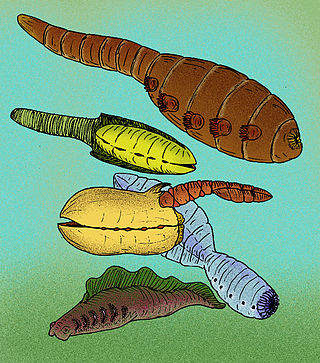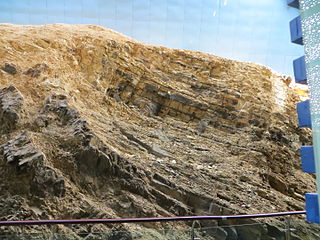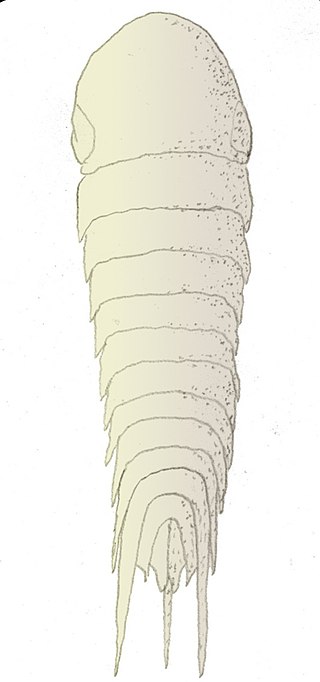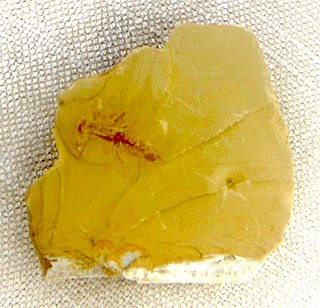
A chordate is a deuterostomic animal belonging to the phylum Chordata. All chordates possess, at some point during their larval or adult stages, five distinctive physical characteristics (synapomorphies) that distinguish them from other taxa. These five synapomorphies are a notochord, a hollow dorsal nerve cord, an endostyle or thyroid, pharyngeal slits, and a post-anal tail. The name "chordate" comes from the first of these synapomorphies, the notochord, which plays a significant role in chordate body plan structuring and movements. Chordates are also bilaterally symmetric, have a coelom, possess a closed circulatory system, and exhibit metameric segmentation.

The Cambrian Period is the first geological period of the Paleozoic Era, and of the Phanerozoic Eon. The Cambrian lasted 53.4 million years from the end of the preceding Ediacaran Period 538.8 million years ago (mya) to the beginning of the Ordovician Period 485.4 mya. Its subdivisions, and its base, are somewhat in flux.

Vetulicolia is a phylum of animals encompassing several extinct species belonging to the Cambrian Period. The phylum was created by Degan Shu and his research team in 2001, and named after Vetulicola cuneata, the first species of the phylum described in 1987. The vetulicolian body comprises two parts: a voluminous anterior forebody, tipped with an anteriorly positioned mouth and lined with a row of five round to oval-shaped features on each lateral side, which have been interpreted as gills ; and a posterior section that primitively comprises seven segments and functions as a tail. All vetulicolians lack preserved appendages of any kind, having no legs, feelers or even eyes. The area where the anterior and posterior parts join is constricted.

The Maotianshan Shales (帽天山页岩) are a series of Early Cambrian sedimentary deposits in the Chiungchussu Formation, famous for their Konservat Lagerstätten, deposits known for the exceptional preservation of fossilized organisms or traces. The Maotianshan Shales form one of some forty Cambrian fossil locations worldwide exhibiting exquisite preservation of rarely preserved, non-mineralized soft tissue, comparable to the fossils of the Burgess Shale of British Columbia, Canada. They take their name from Maotianshan Hill in Chengjiang County, Yunnan Province, China.

Microdictyon is an extinct armoured worm-like panarthropod coated with net-like scleritic plates, known from the Early Cambrian Maotianshan shale of Yunnan China and other parts of the world. Microdictyon is part of the ill-defined taxon – Lobopodia – that includes several other odd worm-like animals that resembling worm with legs, such as Hallucigenia, Onychodictyon, Cardiodictyon, Luolishania, and Paucipodia. The isolated sclerites of Microdictyon are known from other Lower Cambrian deposits. Microdictyon sclerites appear to have moulted; one sclerite seems to have been preserved during ecdysis.
Myllokunmingia is a genus of basal chordate from the Lower Cambrian Maotianshan shales of China 518 to 490 mya and is thought to be a vertebrate, although this is not conclusively proven. The species M. fengjiaoa is 28 mm long and 6 mm high. It is among the oldest possible craniates, found in the lower Cambrian Chengjiang. It appears to have a skull and skeletal structures made of cartilage. There is no sign of biomineralization of the skeletal elements. The holotype was found in the Yuanshan member of the Qiongzhusi Formation in the Eoredlichia Zone near Haikou at Ercaicun, Kunming City, Yunnan, China. Only one species is known – Myllokunmingia fengjiaoa. Related creatures are Haikouichthys and Zhongjianichthys.

Acanthomeridion is an extinct arthropod found in the Chengjiang fauna deposits of China. In 1997, it was placed in its own, monotypic family, Acanthomeridiidae. It is known from eight specimens, all found in China.
The Cambrian explosion, Cambrian radiation,Cambrian diversification, or the Biological Big Bang refers to an interval of time approximately 538.8 million years ago in the Cambrian Period of early Paleozoic when there was a sudden radiation of complex life and practically all major animal phyla started appearing in the fossil record. It lasted for about 13 – 25 million years and resulted in the divergence of most modern metazoan phyla. The event was accompanied by major diversification in other groups of organisms as well.

Cindarella is genus of trilobite-like Cambrian arthropod known from the Chengjiang biota of China. It is classified in the stem group of trilobites (Artiopoda) in the clade Xandarellida, along with Phytophilaspis, Sinoburius, and Xandarella.

Miraluolishania is an extinct lobopodian known from Chengjiang County in China. It is remarkable for the possession of lensed pit-eyes. The only species, Miraluolishania haikouensis, was described from the Maotianshan Shales at Haikou by Jianni Liu and Degan Shu in 2004. In 2009, a team of palaeontologists at the Yunnan University, led by Xiaoya Ma reported the discovery of 42 other specimens from Haikou. With the help of Swiss palaeontologist Jan Bergström, Ma and Hou came to the conclusion that all the specimens were the same species as Luolishania; another lobopod discovered from the Chengjian in 1989. Chengjian is 40 kms from Haikou and the fossil fauna are different. A reassessment by Liu and Shu's team at the Northwest University in 2008 established that Luolishania and Miraluolishania are distinct animals.

Thelxiope is a genus of Cambrian and Ordovician arthropod. Four named species are known, the type species T. palaeothalassia is known from the Burgess Shale, Canada T. holmani is from the Wheeler Shale of Utah, Thelxiope tangi from the Linyi Lagerstätte of Shandong, China, and T. spinosa, which is known from both the Linyi Lagerstätte and the Wheeler Shale. An indeterminate species is also known from the Ordovician (Floian) Fezouata Formation in Morocco. It is a member of Mollisoniida, alongside close relatives Mollisonia, Corcorania and Urokodia. They are suggested to be stem-chelicerates.

Emucarididae is an extinct family of soft-shelled trilobite-like arthropods (nektaspids) from the Lower Cambrian of South Australia and South China. It contains only two genera – Emucaris and Kangacaris. Two species were described in 2010 from specimens recovered from Emu Bay Shale Lagerstätte, one species in 2012 from the Maotianshan Shales. It is classified under the order Nektaspida, and is a sister-group to the families Liwiidae and Naraoiidae.
The Miaolingian is the third Series of the Cambrian Period, and was formally named in 2018. It lasted from about 509 to 497 million years ago and is divided in ascending order into 3 stages: the Wuliuan, Drumian, and Guzhangian. The Miaolingian is preceded by the unnamed Cambrian Series 2 and succeeded by the Furongian series.
Westergaardodina is a species-rich genus of spine, U or W-shaped paraconodont known from Middle Cambrian to Lower Ordovician strata.
Gapparodus is an extinct genus of conodonts in the family Furnishinidae. Gapparodus gapparites is a species of the Early Cambrian of Shuijingtuo Formation in China.

Onychodictyon is a genus of extinct lobopodian known from the Lower Cambrian Chengjiang Maotianshan Shales in the Yunnan Province in China. It was characterized by a stout body covered by fleshy papillae and pairs of sclerotized plates with spines, representing part of the diverse "armoured lobopodians" alongside similar forms such as Microdictyon and Hallucigenia.

Sinoburius is an extinct genus of xandarellid artiopodan known from the Cambrian aged Chengjiang Biota of China. It is only known from the type species S. lunaris, which was described in 1991. It is a rare fossil within the Chengjiang assemblage. Like other Xandarellids, Sinoburius has an unmineralised exoskeleton. Adult individuals are around 7-8 millimetres in length, with stalked eyes present on the ventral side. Unusually among artiopods, the antennae are strongly reduced in size.

Xandarella is an extinct genus of xandarellid artiopodan known from the Cambrian of China and Morocco, the type species Xandarella spectaculum was described in 1991 from the Cambrian Stage 3 aged Chengjiang Biota in China. An additional species Xandarella mauretanica was described from the Cambrian Stage 5 Tatelt Formation in Morocco in 2017, which preserved only the ventral anatomy. Like other Xandarellids, the exoskeleton is unmineralised. The cephalon has pronounced eye slits, presumably derived from ancestral ventral stalked eyes.

Luohuilinella is an extinct genus of xandarellid artiopodan arthropod known from the Chengjiang biota of China. The type species Luohuilinella rarus was described in 2012. A second species Luohuilinella deletres was described in 2018. Both taxa are rare components of the assemblage. Like other Xandarellids and most artiopodans, it possessed an unmineralised exoskeleton. The type and currently only known specimen of L. rarus is known from a dorsal exoskeleton, around 17 mm long and 9 mm wide which consists of 27 tergites with pronounced pleural spines. L. deletres is much larger, with specimens being over 10 cm long, L. deletres possessed at least 11 pairs of biramous appendages. Both taxa are dorsoventrally flattened, making a benthic or nektobenthic lifestyle probable. Both taxa have pronounced notches in the cephalon to accommodate the stalked eyes.

Houcaris is a possibly paraphyletic radiodont genus, tentatively assigned to either Amplectobeluidae, Anomalocarididae or Tamisiocarididae, known from Cambrian Series 2 of China and the United States. It contains two species, Houcaris saron and Houcaris magnabasis, both of which were originally named as species of the related genus Anomalocaris. The genus Houcaris was established for the two species in 2021 and honors Hou Xianguang, who had discovered and named the type species Anomalocaris saron in 1995 along with his colleagues Jan Bergström and Per E. Ahlberg.














